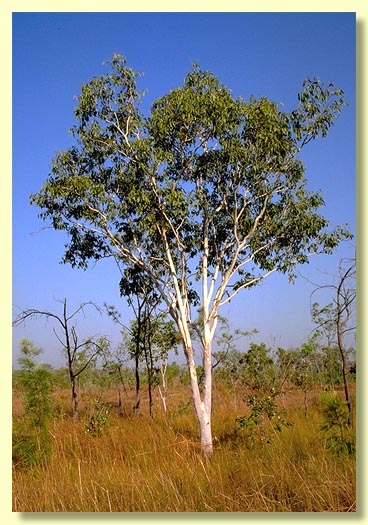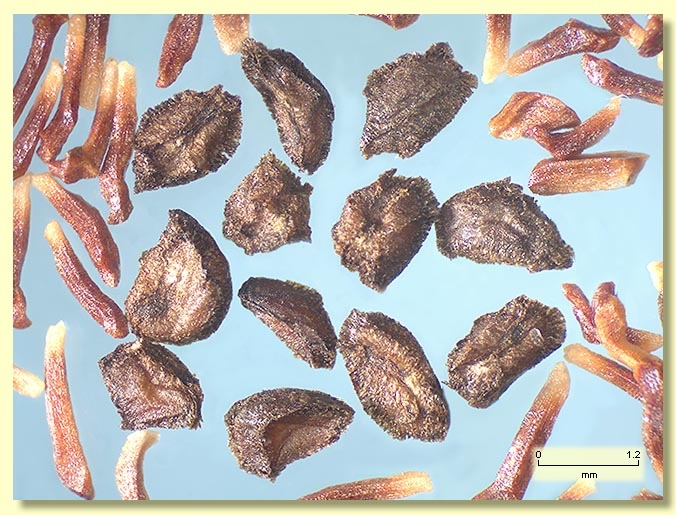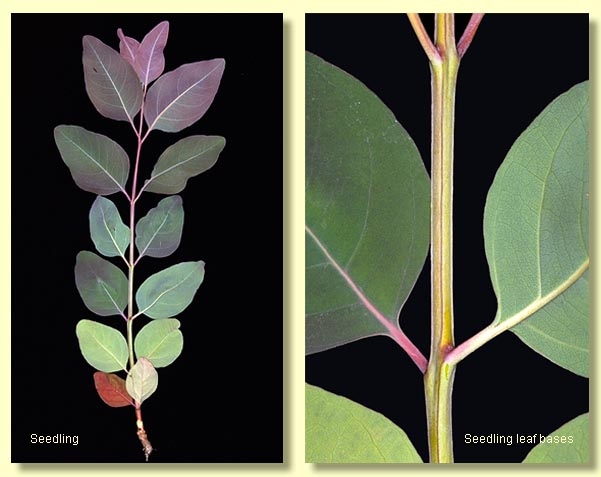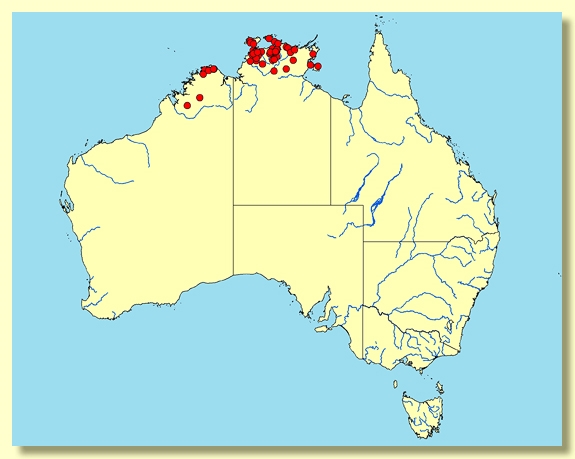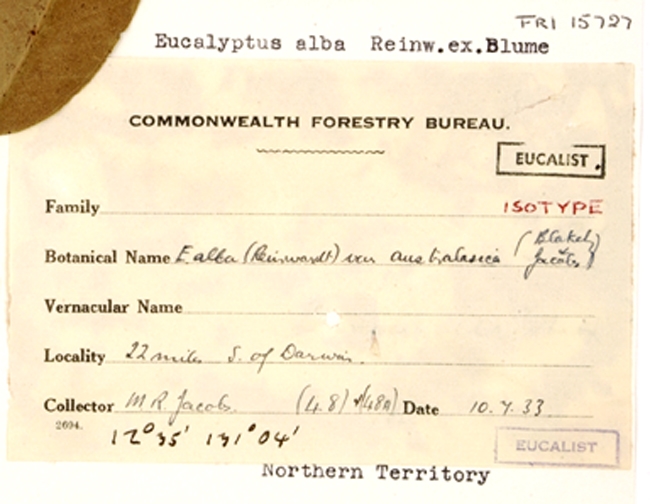Euclid - Online edition
Eucalyptus alba var. australasica
Eucalyptus | Symphyomyrtus | Exsertaria | Subexsertae | Applanatae
Eucalyptus alba var. australasica Blakely & Jacobs ex Blakely, Key Eucalypts 137 (1934).
T: 22 miles [c. 35 km] S of Darwin, Northern Territory, 10 July 1933, M.R.Jacobs 48; lecto: NSW, fide S.T. Blake, Austral. J. Bot. 1: 276 (1953); isolecto: BRI, CANB.
Tree to c. 20 m tall, often deciduous during the drier months prior to the wet season. Forming a lignotuber.
Bark smooth, new bark pale orange to pale pink to pale yellow to creamy-white, maturing to white and weathering to grey or reddish brown just before decortication.
Juvenile growth (coppice or field seedlings to 50 cm): stems square to round in cross-section, not glaucous; juvenile leaves always petiolate, alternate, ovate, 10–18 cm long, 6–13.5 cm wide, base broadly lobed to truncate to rounded, green.
Adult leaves alternate, petioles 1.5–4 cm long; blade lanceolate to broadly lanceolate to occasionally ovate, 8–18.5 cm long, (1.8)2.5–4.5(8) cm wide, base rounded to tapering to petiole, margin entire, apex pointed, concolorous, dull to slightly glossy green, side-veins acute or at a wider angle than 45° to the midrib, reticulation very dense, intramarginal vein present, oil glands mostly intersectional, rarely island, or sometimes somewhat obscure.
Inflorescence axillary unbranched, peduncles 0.5–1 cm long, angular, buds 7 per umbel, pedicellate (pedicels 0.2–0.4 cm long). Mature buds obovoid to obovoid or globular, 0.4–0.8 cm long, 0.4–0.6 cm wide, scar present, operculum rounded to shortly beaked (0.2–0.5 cm long), hypanthium often with two weak longitudinal ridges, stamens regularly inflexed, rarely irregularly inflexed, anthers oblong, versatile, dorsifixed, dehiscing by longitudinal slits, style long and straight, rarely hooked beneath the top of the operculum, stigma blunt, locules (3)4, the placentae each with 6 or more vertical rows of ovules. Flowers white.
Fruit pedicellate (pedicels 0.1–0.5 cm long), obconical to hemispherical, non-glaucous, 0.3–0.6 cm long, 0.5–0.8 cm wide, disc raised and annular, valves (3)4, exserted.
Seeds brown, 1.5–2 mm long, ± flattened ovoid to rarely pyramidal, dorsal surface shallowly reticulate, edge of seed sharply toothed, hilum ventral.
Cultivated seedlings (measured at ca node 10): cotyledons oblong, stem square in cross-section and prominently winged; leaves opposite for c. 5 to 8 nodes, then alternate, always petiolate, ovate, 7–10.8 cm long, 4–6.2 cm wide, base rounded to tapering to the petiole, dull green to grey-green.
Flowering has been recorded in July, August and September.
A medium-sized tree, common along watercourses and seasonally flooded, low-lying areas of the Top End of the Northern Territory and the northern Kimberley region of Western Australia. Characterised by the smooth white bark, the broadly lanceolate to ovate adult leaves, the obovoid to globular buds and hemispherical to obconical fruit with a raised annular disc and prominently exserted valves.
Eucalyptus alba belongs to a small group of species commonly referred to as the northern red gums (Eucalyptus subgenus Symphyomyrtus section Exsertaria series Subexsertae subseries Applanatae). This group is distinguished by having smooth powdery bark, adult leaves with dense to very dense venation and intersectional or absent oil glands, buds with inflexed stamens, fruit with an annular disc and ± flattened, toothed seeds with a ventral hilum. Other members of this group are E. bigalerita, E. platyphylla, E. tintinnans, E. apodophylla and E. houseana.
Within this group, E. alba is closest to E. platyphylla and is only weakly separated by the width of the adult leaves (usually wider than 5 cm in E. platyphylla and less than 5 cm in E. alba; however, there is some overlap, with some individuals from both taxa falling outside these criteria). It is also very close to E. houseana and is weakly distinguished by having slightly larger, pedicellate buds and fruit with prominently exserted valves (fruit normally 0.5 cm or wider in E. alba but for E. houseana, 0.5 cm or narrower, ± sessile and the valves of the fruit near the rim or only slightly exserted). It is also close to E. bigalerita and E. tintinnans and is distinguished from both by the shape of the adult leaves, which are normally broadly lanceolate to occasionally ovate in E. alba but orbicular to deltoid in both E. bigalerita and E. tintinnans. E. apodophylla differs by having opposite, blue-grey to glaucous, sessile to shortly petiolate adult leaves (always distinctly petiolate, alternate and dull to slightly glossy green in E. alba).
E. hallii and E. broviniensis, at present placed in a different group, i.e. the series Connexentes, are also very close to E. alba var. australasica. E. alba var. australasica differs only marginally from both by having distinctly pedicellate buds and fruit and by its hemispherical to funnel-shaped fruit with the valves not as prominently exserted. (The buds and fruit of E. hallii and E. broviniensis are sessile to shortly pedicellate and the fruit is always funnel-shaped with strongly exserted valves). The bark of both E. hallii and E. broviniensis is often granular, like grey gum bark, while the bark of E. alba var. australasica is never granular and often powdery.
Within its area of occurrence, E. alba var. australasica may be confused with other related white gums, i.e. E.brevifolia, E. confluens, E. cupularis, E. glomericassis, E. herbertiana, E. mooreana, E. ordiana, E. pantoleuca, E. rupestris and E. umbrawarrensis.
E. confluens, E. cupularis, E. glomericassis, E. herbertiana, E. rupestris and E. umbrawarrensis all have adult leaves narrower than 2.5 cm (E. alba var. australasica normally with adult leaves wider than 2.5 cm). The adult leaves of E. cupularis can sometimes be slightly wider than 2.5 cm, thus overlapping slightly the range of E. alba. E. cupularis can be further distinguished by having glaucous buds and branchlets. (The buds and branchlets of E. alba var. australasica are normally not glaucous).
E. brevifolia, E. ordiana, E. pantoleuca and E. mooreana can be distinguished by having glaucous or blue-grey adult leaves (E. alba var. australasica with green adult leaves).
There are two varieties of E. alba:
var. alba
Only known from East Timor and does not occur on mainland Australia. Differs from var. australasica by having larger fruit (fruit to 1.5 cm wide).
var. australasica (referring to its occurrence on mainland Australia)
Differs from var. alba by having smaller fruit (fruit width no wider than 0.8 cm).
(The relationships between Eucalyptus alba var. alba, E. alba var. australasica, E. bigalerita, E. hallii, E. platyphylla and E. tintinnans need further investigation. E. alba var. alba, E. bigalerita, E. platyphylla and E. tintinnans are all very similar, and the taxonomy, largely based on the size of adult leaves, buds and fruit, does not appear to work across the full range for this group. It may be better that all four species be placed in one variable taxon, using the oldest name, Eucalyptus alba. Such a revision is beyond the scope of EUCLID; thus we have adopted the current curatorial status for this group.)
Eucalyptus alba: Latin albus, white, referring to the colour of the bark.

